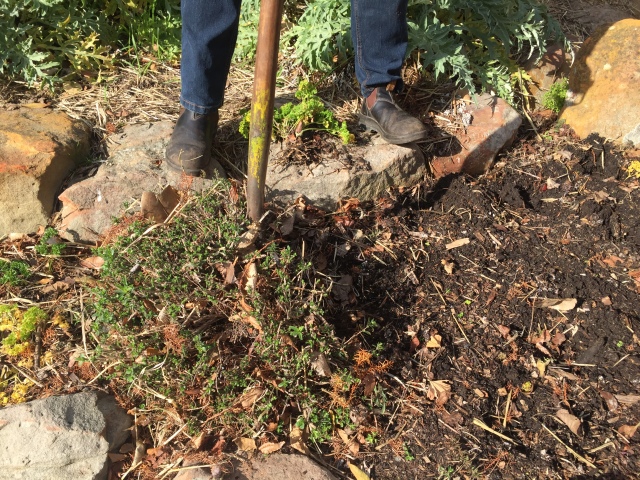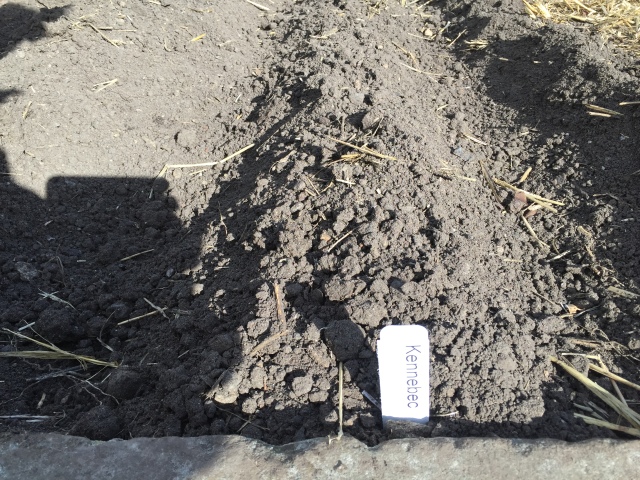Another sunny, glorious Thursday and I went off to volunteer in the Community Food Garden at the Royal Tasmanian Botanical Gardens (RTBG). Superb natural vistas presented themselves as I walked along the path.
 I arrived early and Coordinator Adam directed me to my first project for the day.
I arrived early and Coordinator Adam directed me to my first project for the day.
The job was to de-weed the ground beneath the walls of passionfruit vines, strew ‘Rocket Fuel’ pellets across the surface, then load an inch or two of fresh compost over those garden beds and level this out. I asked whether I should dig in the fertiliser and or compost. No. Why not? Because any soil disturbance is likely to encourage suckers to flourish and seeds to sprout. Wonderful. I never really like digging. Can do but would rather not. And what was this thing called ‘Rocket Fuel’? We walked to the tool shed and Adam showed me a bag.
And what was this thing called ‘Rocket Fuel’? We walked to the tool shed and Adam showed me a bag.

Apparently as a volunteer I am entitled to order through the RTBG when they put in an order if I wish. Of course I will have to pay for my own. So I look forward to the next time an order is made. The pellets smelled terrific. Rich and good enough to eat. I was working in a very public area with people walking by all the time. A couple of ladies were so enamoured of the process that I offered them the chance to smell these pellets – I was using a small bucket which contained a kilo or so. They stuck their noses in and loved it as well and expected to get some when they returned interstate to their own gardens. Adam went off in the buggy and filled the back with a load of composted soil. Perfectly loamy for air to penetrate. Perfectly open for water to penetrate. Shovelling it across and up onto the raised beds was not a smart option. Instead, in small bucket loads I gradually emptied the buggy and covered the ground. Two buggy loads later the beds were covered. Very neat. Apparently the passionfruit will take off again within the next or 5 weeks so that any intervening rain and watering will settle the new layers and begin to let their nutrient goodness descend to the plant roots, to give each plant vigour and growth.
Adam went off in the buggy and filled the back with a load of composted soil. Perfectly loamy for air to penetrate. Perfectly open for water to penetrate. Shovelling it across and up onto the raised beds was not a smart option. Instead, in small bucket loads I gradually emptied the buggy and covered the ground. Two buggy loads later the beds were covered. Very neat. Apparently the passionfruit will take off again within the next or 5 weeks so that any intervening rain and watering will settle the new layers and begin to let their nutrient goodness descend to the plant roots, to give each plant vigour and growth.
 I was delighted to be able to use new knowledge. Last Tuesday when I attended an Information Day specifically offered to volunteers from across RTBG, we learnt about the collections of Tasmanian plants and where they are located across the grounds. While I was moving soil, three interstate visitors stood puzzling over the Garden’s map. ‘Can I help?’ ‘Yes – where are the Tasmanian Gardens from here?’ Thankful to be able to provide clear advice, I pointed to all the locations on their map where clusters of Tasmanian plants can be found.
I was delighted to be able to use new knowledge. Last Tuesday when I attended an Information Day specifically offered to volunteers from across RTBG, we learnt about the collections of Tasmanian plants and where they are located across the grounds. While I was moving soil, three interstate visitors stood puzzling over the Garden’s map. ‘Can I help?’ ‘Yes – where are the Tasmanian Gardens from here?’ Thankful to be able to provide clear advice, I pointed to all the locations on their map where clusters of Tasmanian plants can be found.
I stopped the restaurant chef for a chat, as he passed me by after snipping a few herbs for use in the lunchtime cook. I congratulated him on the superb vegan soups that he always seemed to have on offer every time I have lunched there. Superb because of the depth of flavour. Apparently he has been trained how to pick the herbs without killing off the garden plants and so he is welcome to return daily for new pickings. Later in the day someone said they had enjoyed the savoury scones offered by the restaurant but felt the herbs were out of a jar. They suggested the scones would have more flavour with fresh herbs. I must ask the chef about that if I should see him again.
As I finished the passionfruit garden job, another volunteer came looking for me to say it was lunchtime. As usual we sat in the sun, enjoying that wonderful part of the world, surveying ‘our kingdom’, and telling each other what we had been doing that morning.
I don’t know the half of what was achieved, but I do know brassica and other leaves were picked for distribution through Second Bite, some coriander plants were pulled in order to set up potato beds, plant different potato varieties and label, some beds were mulched with straw, broad beans were sown, well established seedlings of Japanese White turnip were planted, self-seeded Cos lettuce plants were removed and planted appropriately in other beds, aged spreading marjoram with thick deep roots was struggled with and dug out, an old clump of summer savoury was removed (I tasted this herb for the first time and it’s tasty tangy lemon flavour was so refreshing-note to self, must grow this). 







 After lunch I walked off, with weeding bin in hand, to de-weed the large bed adjacent to the area with the passionfruit vines. A few well established olive trees and flourishing artichoke plants were scattered across this area. Weeds had infiltrated the ground cover of golden marjoram. I started sitting comfortably on a sandstone wall and meticulously taking out each weed. ‘Oh you have found this next big project’. Coordinator Adam’s voice came through clearly. ‘I will be getting everyone involved with this’, he explained. He provided details on one of the weeds, one I was not familiar with although it is similar to one in my own garden. This was a very tricky plant and had different forms at different stages of growth. It loved to masquerade as ground creeping marjoram. It had to go, and a team of us worked at its removal, and that of a few other unwanted plants aka weeds.
After lunch I walked off, with weeding bin in hand, to de-weed the large bed adjacent to the area with the passionfruit vines. A few well established olive trees and flourishing artichoke plants were scattered across this area. Weeds had infiltrated the ground cover of golden marjoram. I started sitting comfortably on a sandstone wall and meticulously taking out each weed. ‘Oh you have found this next big project’. Coordinator Adam’s voice came through clearly. ‘I will be getting everyone involved with this’, he explained. He provided details on one of the weeds, one I was not familiar with although it is similar to one in my own garden. This was a very tricky plant and had different forms at different stages of growth. It loved to masquerade as ground creeping marjoram. It had to go, and a team of us worked at its removal, and that of a few other unwanted plants aka weeds.
Five hours after my arrival I felt enough was enough. Packed up slowly. Changed my shoes. Thoroughly washed the caked dirt off my hands, and attempted to clean my fingernails (weeding gloves are too thick and clumsy for me). In the photo below the blue flowering plant is the herb Borage.
 Time to go. Satisfied and happy I meandered off towards the bus stop.
Time to go. Satisfied and happy I meandered off towards the bus stop.
